Boeing 727
| Boeing 727 | |
|---|---|
 | |
| Champion Air Boeing 727-200 Advanced | |
| Role | Narrow-body jet airliner |
| National origin | United States |
| Manufacturer | Boeing Commercial Airplanes |
| First flight | February 9, 1963 |
| Introduction | February 1, 1964 with Eastern Airlines |
| Status | In limited service for cargo and private transport |
| Primary users | Kelowna Flightcraft Air Charter Champion Air (historical) Kalitta Charters Iran Aseman Airlines |
| Produced | 1962–1984 |
| Number built | 1,832[1] |
| Unit cost |
$4.25 million initially, $22 million by 1982 |
The Boeing 727 is a midsized, narrow-body three-engined jet aircraft built by Boeing Commercial Airplanes from the early 1960s to 1984.[1] It can carry 149 to 189 passengers and later models can fly up to 2,700 nautical miles (5,000 km) nonstop. Intended for short and medium-length flights, the 727 can use relatively short runways at smaller airports. It has three Pratt & Whitney JT8D engines below the T-tail, one on each side of the rear fuselage with a center engine that connects through an S-duct to an inlet at the base of the fin. The 727 is Boeing's only trijet aircraft.
The 727 followed the 707, a quad-jet airliner, with which it shares its upper fuselage cross-section and cockpit design. The 727-100 first flew in February 1963 and entered service with Eastern Air Lines in February 1964; the stretched 727-200 flew in July 1967 and entered service with Northeast Airlines that December. The 727 became a mainstay of airlines' domestic route networks and was also used on short- and medium-range international routes. Passenger, freighter, and convertible versions of the 727 were built.
The 727 was heavily produced into the 1970s; the last 727 was completed in 1984. As of July 2013, a total of 109 Boeing 727s (5× 727-100s and 104× -200s) were in commercial service with 34 airlines.[2] Airport noise regulations have led to 727s being equipped with hush kits.
Development
The Boeing 727 design was a compromise among United Airlines, American Airlines, and Eastern Air Lines; each of the three had developed requirements for a jet airliner to serve smaller cities with shorter runways and fewer passengers.[3] United Airlines requested a four-engine aircraft for its flights to high-altitude airports, especially its hub at Stapleton International Airport in Denver, Colorado.[3] American Airlines, which was operating the four-engined Boeing 707 and Boeing 720, requested a twin-engined aircraft for efficiency. Eastern Airlines wanted a third engine for its overwater flights to the Caribbean, since at that time twin-engine commercial flights were limited by regulations to routes with 60-minute maximum flying time to an airport (see ETOPS). Eventually, the three airlines agreed on a trijet design for the new aircraft.[3]

In 1959, Lord Douglas, chairman of British European Airways (BEA), suggested that Boeing and de Havilland Aircraft Company (later Hawker Siddeley) work together on their trijet designs, the 727 and D.H.121 Trident, respectively.[4] The two designs had a similar layout, the 727 being slightly larger. At that time Boeing intended to use three Allison AR963 turbofan engines, license-built versions of the Rolls-Royce RB163 Spey used by the Trident.[5][6] Boeing and de Havilland each sent engineers to the other company's locations to evaluate each other's designs, but Boeing eventually decided against the joint venture.[7] De Havilland had wanted Boeing to license-build the D.H.121, while Boeing felt that the aircraft needed to be designed for the American market, with six-abreast seating and the ability to use runways as short as 4,500 ft.[8]
In 1960, Pratt & Whitney was looking for a customer for its new JT8D turbofan design study, based on its J52 (JT8A) turbojet,[9] while United and Eastern were interested in a Pratt & Whitney alternative to the RB163 Spey.[10] Once Pratt & Whitney agreed to go ahead with development of the JT8D, Eddie Rickenbacker, chairman of the board of Eastern, told Boeing that the airline preferred the JT8D for its 727s. Boeing had not offered the JT8D, as it was about 1,000 lb heavier than the RB163, though slightly more powerful; the RB163 was also further along in development than the JT8D. Boeing reluctantly agreed to offer the JT8D as an option on the 727 and it later became the sole powerplant.[11]
With high-lift devices[12] on its wing, the 727 could use shorter runways than most earlier jets (e.g. the 4800-ft runway at Key West).
Later 727 models were stretched to carry more passengers[13] and replaced earlier jet airliners such as the Boeing 707 and Douglas DC-8, as well as aging propeller airliners such as the DC-4, DC-6, DC-7, and the Lockheed Constellations on short- and medium-haul routes.
For over a decade, more 727s were built per year than any other jet airliner; in 1984, production ended with 1,832 built[1] and 1,831 delivered, the highest total for any jet airliner until the 737 surpassed it in the early 1990s.[14]
Design

The airliner's middle engine (engine 2) at the very rear of the fuselage gets air from an inlet ahead of the vertical fin through an S-shaped duct.[15] This S-duct proved to be troublesome in that flow distortion in the duct induced a surge in the centerline engine on the take-off of the first flight of the 727-100.[16] This was fixed by the addition of several large vortex generators in the inside of the first bend of the duct.
The 727 was designed for smaller airports, so independence from ground facilities was an important requirement. This led to one of the 727's most distinctive features: the built-in airstair that opens from the rear underbelly of the fuselage, which initially could be opened in flight.[12] Hijacker D. B. Cooper parachuted from the back of a 727 as it was flying over the Pacific Northwest. Boeing subsequently modified the design with the Cooper vane so that the airstair could not be lowered in flight.[17] Another innovation was the auxiliary power unit (APU), which allowed electrical and air-conditioning systems to run independently of a ground-based power supply, and without having to start one of the main engines. An unusual design feature is that the APU is mounted in a hole in the keel beam web, in the main landing gear bay.[16] The 727 is equipped with a retractable tail skid that is designed to protect the aircraft in the event of an over-rotation on takeoff. The 727's fuselage has an outer diameter of 148 inches (3.8 m). This allows six-abreast seating (three per side) and a single aisle when 18-inch (46 cm) wide coach-class seats are installed. An unusual feature of the fuselage is the 10-inch (25 cm) difference between the lower lobe forward and aft of the wing as the higher fuselage height of the center section was simply retained towards the rear.

Nose wheel brakes were available as an option to reduce braking distance on landing, which provided reductions in braking distances of up to 150 m.[18]
The 727 proved to be such a reliable and versatile airliner that it came to form the core of many startup airlines' fleets. The 727 was successful with airlines worldwide partly because it could use smaller runways while still flying medium-range routes. This allowed airlines to carry passengers from cities with large populations, but smaller airports to worldwide tourist destinations. One of the features that gave the 727 its ability to land on shorter runways was its clean wing design.[12] With no wing-mounted engines, leading-edge devices (Krueger, or hinged, flaps on the inner wing and extendable leading edge slats out to the wingtip) and trailing-edge lift enhancement equipment (triple-slotted,[19] fowler flaps) could be used on the entire wing. Together, these high-lift devices produced a maximum wing lift coefficient of 3.0 (based on the flap-retracted wing area).[16] The 727 was stable at very low speeds compared to other early jets, but some domestic carriers learned after review of various accidents that the 40-degree flaps setting could result in a higher-than-desired sink rate or a stall on final approach. These carriers' Pilots' Operation Handbooks disallowed using more than 30° of flaps on the 727, even going so far as installing plates on the flap lever slot to prevent selection of more than 30° of flaps.
Noise
The 727 is one of the noisiest commercial jetliners, categorized as Stage 2 by the U.S. Noise Control Act of 1972, which mandated the gradual introduction of quieter Stage 3 aircraft. The 727's JT8D jet engines use older low-bypass turbofan technology, whereas Stage 3 aircraft use the more efficient and quieter high-bypass turbofan design. When the Stage 3 requirement was being proposed, Boeing engineers analyzed the possibility of incorporating quieter engines on the 727. They determined that the JT8D-200 engine could be used on the two side-mounted pylons, but the structural changes to fit the larger-diameter engine (49.2 inches (125 cm) fan diameter in the JT8D-200 compared to 39.9 inches (101 cm) in the JT8D-7) into the fuselage at the number two engine location were prohibitive.
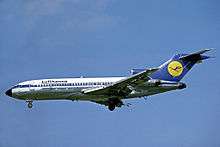
Current regulations require that a 727 in commercial service must be retrofitted with a hush kit to reduce engine noise to Stage 3 levels. One such hush kit is offered by FedEx,[20] and has been purchased by over 60 customers.[21] Aftermarket winglet kits, originally developed by Valsan Partners and later marketed by Quiet Wing Corp.[22] have been installed on many 727s to reduce noise at lower speeds, as well as to reduce fuel consumption. In addition, Raisbeck Engineering developed packages to enable 727s to meet the Stage 3 noise requirements. These packages managed to get light- and medium-weight 727s to meet Stage 3 with simple changes to the flap and slat schedules. For heavier-weight 727s, exhaust mixers must be added to meet Stage 3.[22] American Airlines ordered and took delivery of 52 Raisbeck 727 Stage 3 systems. Other customers included TWA, Pan Am, Air Algérie, TAME, and many smaller airlines.[23][24]
Since September 1, 2010, 727 jetliners (including those with a hush kit) are banned from some Australian airports because they are too loud.[25]
Operational history
In addition to domestic flights of medium range, the 727 was popular with international passenger airlines.[13] The range of flights it could cover (and the additional safety added by the third engine) meant that the 727 proved efficient for short- to medium-range international flights in areas around the world. Prior to its introduction, four-engined jets or propeller-driven airliners were required for transoceanic service.
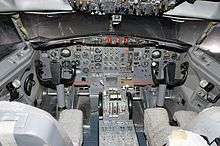
The 727 also proved popular with cargo and charter airlines. FedEx Express introduced 727s in 1978.[26] The 727s were the backbone of its fleet until the 2000s; FedEx began replacing them with Boeing 757s in 2007.[26] Many cargo airlines worldwide employ the 727 as a workhorse, since, as it is being phased out of U.S. domestic service because of noise regulations, it becomes available to overseas users in areas where such noise regulations have not yet been instituted. Charter airlines Sun Country, Champion Air, and Ryan International Airlines all started with 727 aircraft.
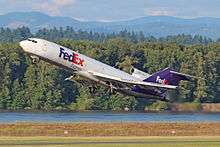
The 727 had some military uses, as well. Since the aft stair could be opened in flight, the Central Intelligence Agency used them to drop agents and supplies behind enemy lines in Vietnam.[27]
The 727 has proven to be popular where the airline serves airports with gravel, or otherwise lightly improved, runways. The Canadian airline First Air, for example, previously used a 727-100C to serve the communities of Resolute Bay and Arctic Bay in Nunavut, whose Resolute Bay Airport and former Nanisivik Airport both have gravel runways. The high-mounted engines greatly reduce the risk of foreign object damage.
According to the Boeing Jetliner Databook, the Justice Prisoner and Alien Transportation System, also known as 'Con Air', currently uses four 727 aircraft to transport persons in legal custody between prisons, detention centers, courthouses, and other places.
A military version, the Boeing C-22, was operated as a medium-range transport aircraft by the Air National Guard and National Guard Bureau to airlift personnel. A total of three C-22Bs were in use, all assigned to the 201st Airlift Squadron, District of Columbia Air National Guard.[28]
.jpg)
At the start of the 21st century, the 727 remained in service with a few large airlines. Faced with higher fuel costs, lower passenger volumes due to the post-9/11 economic climate, increasing restrictions on airport noise, and the extra expenses of maintaining older planes and paying flight engineers' salaries, most major airlines phased out their 727s; they were replaced by twin-engined aircraft, which are quieter and more fuel-efficient. Modern airliners also have a smaller flight deck crew of two pilots, while the 727 required two pilots and a flight engineer. Delta Air Lines, the last major U.S. carrier to do so, retired its last 727 from scheduled service in April 2003. Northwest Airlines retired its last 727 from charter service in June 2003. Many airlines replaced their 727s with either the 737-800 or the Airbus A320; both are close in size to the 727-200. As of July 2013, a total of 109 Boeing 727s (5× 727-100s and 104× -200s) were in commercial service with 34 airlines.[2]
On March 2, 2016, the first 727 produced (N7001U), which first flew on February 9, 1963, made its final flight. The 727-100 had carried about three million passengers during its years of service. Originally a prototype, it was later sold to United Airlines, which donated it to the museum in 1991. The Federal Aviation Administration granted the museum a special permit for the 15-minute flight. The jet was restored over 25 years by the Museum of Flight in Seattle and was ferried from Paine Field in Everett, Washington to Boeing Field in Seattle, where it was put on permanent display at the Aviation Pavilion.[29][30][31] The museum's previous 727-223, tail number N874AA, was donated to the National Airline History Museum in Kansas City and will be flown to its new home once FAA ferry approval is granted.[32]
Variants
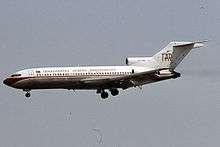
Data from:Boeing Aircraft since 1916[33]
The two series of 727 are the initial 100 (originally only two figures as in −30), which was launched in 1960 and entered service in February 1964, and the 727-200 series, which was launched in 1965 and entered service in December 1967.
727-100
The first 727-100 (N7001U) flew on February 9, 1963[29] and FAA type approval was awarded on December 24 of that year, with initial delivery to United Airlines on October 29, 1963, to allow pilot training to commence. The first 727 passenger service was flown by Eastern Air Lines on February 1, 1964, between Miami, Washington, DC, and Philadelphia.
A total of 571 Boeing 727-00/100 series aircraft were delivered (407 -100s, 53 -100Cs, and 111 -100QCs), the last in October 1972. One 727-100 was retained by Boeing, bringing total production to 572.[34]
The −100 designation is a retroactive one to distinguish the original short-body version. Aircraft for United Airlines were delivered as 727-22, for American Airlines as 727-23, and so on — not -122 and -123 — and retained these designations even after the advent of the 727-200.
- 727-100C
Convertible passenger cargo version, additional freight door and strengthened floor and floor beams, three alternate fits:
- 94 mixed-class passengers
- 52 mixed-class passengers and four cargo pallets (22,700 pounds; 10,300 kg)
- Eight cargo pallets (38,000 pounds; 17,000 kg)
- 727-100QC
QC stands for Quick Change. This is similar to the convertible version with a roller-bearing floor for palletised galley and seating and/or cargo to allow much faster changeover time (30 minutes).
- 727-100QF
QF stands for Quiet Freighter. A cargo conversion for United Parcel Service, these were re-engined with Stage 3-compliant Rolls-Royce Tay turbofans.
- Boeing C-22A
- A single 727-30 acquired from the Federal Aviation Administration, it was originally delivered to Lufthansa. This aircraft served mostly with United States Southern Command flying from Panama City / Howard Air Force Base.
- Boeing C-22B
- Four 727-35 aircraft were acquired from National Airlines by the United States Air Force for transporting Air National Guard and National Guard personnel.
727-200

%3B_HK-4354%40UIO%3B22.06.2008_514bn_(4276333230).jpg)
A stretched version of the 727-100, the -200 is 20 feet (6.1 m) longer (153 feet 2 inches;46.69 m) than the −100 (133 feet 2 inches;40.59 m). A 10-ft (3-m) fuselage section ("plug") was added in front of the wings and another 10-ft fuselage section was added behind them. The wing span and height remain the same on both the −100 and −200 (108 and 34 feet (33 and 10 m), respectively). The original 727-200 had the same maximum gross weight as the 727-100; however, as the aircraft evolved, a series of higher gross weights and more powerful engines was introduced along with other improvements, and from line number 881, 727-200s are dubbed −200 Advanced. The aircraft gross weight eventually increased from 169,000 to 209,500 pounds (76,700 to 95,000 kg) for the latest versions. The dorsal intake of the number-two engine was also redesigned to be round in shape, rather than oval as it was on the -100 series.
The first 727-200 flew on July 27, 1967, and received FAA certification on November 30, 1967. The first delivery was made on December 14, 1967, to Northeast Airlines. A total of 310 727-200s were delivered before its place on the production line was taken over by the 727-200 Advanced in 1972.
- 727-200C
A convertible passenger cargo version, only one was built.

- 727-200 Advanced
The Advanced version of the 727-200, introduced in 1970, gave the program a new source of life.[35] More powerful engines, increases in both fuel capacity and MTOW, and an increase in range by nearly 50%, combined with excellent economics and improved interior, made the 727-200 Advanced a major success.[36] After the first delivery in mid-1972, Boeing eventually raised production to more than a hundred a year to meet demand by the late '70s. Of the passenger model of the 727-200 Advanced, a total of 935 were delivered, after which it had to give way to a new generation of aircraft.
- 727-200F Advanced
A freighter version of the 727-200 Advanced became available in 1981 designated the Series 200F Advanced powered by the Pratt & Whitney JT8D-17A engines and featured a strengthened fuselage structure, an 11 ft 2 inch by 7 ft 2 inch forward main deck freight door, and a windowless cabin. This was the last production variant of the 727 to be developed by Boeing, and 15 aircraft were built, all for Federal Express; the last 727 aircraft completed by Boeing was a 727-200F Advanced.
- Super 27
Speed was increased by 50 mph (80 km/h) by replacement of the two side engines with the JT8D-217 or the JT8D-219, which are also found on many MD-80s, along with the addition of hush kits to the center engine. Winglets were added to some of these aircraft to increase fuel efficiency. This modification was originally developed by Valsan Partners, but was later marketed by Quiet Wing Technologies in Redmond, Washington.[37]
- Boeing C-22C
- A single 727-212 aircraft was operated by the USAF.
Operators
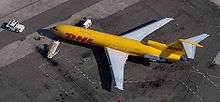
.jpg)
As of June 2013, 188 Boeing 727 aircraft (all variants) are in commercial airline, private, and government service. Most airlines have small numbers, but these operate five or more aircraft:.[38]
- Cargojet Airways (10)[39]
- Iran Aseman Airlines (6)
- Kalitta Charters (9)
- Líneas Aéreas Suramericanas (8)
- Rio Linhas Aéreas (5)
- Total Linhas Aéreas (5)
Government, military, and other operators
In addition, the 727 has seen sporadic government use, having flown for the Belgian, Yugoslavian, Mexican, New Zealand, and Panama air forces, among the small group of government agencies that have used it. The United States military used the 727 as a military transport, designated as the C-22.
- Afghan Air Force - three on order as of December 2014.[40]
- Bolivian Air Force (Transporte Aereo Militar) (1)
- Force Aérienne de Burkina Faso (1)
- Iraqi government, Salah Aldin (1)
Specifications

| 727-100 (Passenger) | 727-200 | 727-200 Advanced | |
|---|---|---|---|
| Seating capacity | 131[42] passengers (one-class, maximum) | 189 passengers (one-class) 145 passengers (two-class) | |
| Cargo capacity | |||
| Crew | 3 flight crew plus ca. 4 cabin crew | ||
| Total length | 133 ft 2 in (40.59 m) | 153 ft 2 in (46.69 m) | |
| Cabin width | 11 ft 6 in (3.51 m) | ||
| Wingspan | 108 ft 0 in (32.92 m) | ||
| Wing area | 1,650 sq ft (153 m2) | ||
| Tail height | 34 ft 0 in (10.36 m) | ||
| Maximum Takeoff Weight (MTOW) * |
170,000 lb (77,000 kg) | 184,800 lb (83,800 kg) | 209,500 lb (95,000 kg) |
| Operating empty weight | 80,602 lb (36,560 kg) | 98,400 lb (44,600 kg) | 102,900 lb (46,700 kg) |
| Max. fuel capacity | 7,680 US gal (29,100 l) | 8,090 US gal (30,600 l) | 8,090 US gal (30,600 l) (Standard) 10,520 US gal (39,800 l) (optional) |
| Take-off distance at MTOW[43] | 8,300 ft (2,500 m) | 10,000 ft (3,000 m) | 8,500 ft (2,600 m) |
| Max range[43] (with full load) |
2,300 nmi (4,300 km) | 1,700 nmi (3,100 km) | 1,900 nmi (3,500 km) (Standard) 2,600 nmi (4,800 km) (Optional) |
| Max cruise speed | Mach 0.9 | ||
| Typical cruise speed | 540 mph (470 kn) | ||
| Service ceiling | 36,100 ft (11,000 m) | 42,000 ft (13,000 m) | 42,000 ft (13,000 m) |
| Rate of climb | 2,940 ft/min (14.9 m/s) | ||
| Engines (3x) | Pratt & Whitney JT8D-1 14,000 lbf (62 kN) thrust each |
Pratt & Whitney JT8D-9 14,500 lbf (64 kN) thrust each |
Pratt & Whitney JT8D-17R 17,400 lbf (77 kN) thrust each |
Sources: Boeing Aircraft since 1916,[33] Airport report[44]
Accidents and incidents
As of July 2015, a total of 336 incidents involving 727s had occurred, including 118 hull-loss accidents[45] resulting in a total of 4,209 fatalities. The 727 has also been in 178 hijackings involving 345 fatalities.[46]
Orders and deliveries
| Year | Total | 1984 | 1983 | 1982 | 1981 | 1980 | 1979 | 1978 | 1977 | 1976 | 1975 | 1974 | 1973 | 1972 | 1971 | 1970 | 1969 | 1968 | 1967 | 1966 | 1965 | 1964 | 1963 | 1962 | 1961 | 1960 |
|---|---|---|---|---|---|---|---|---|---|---|---|---|---|---|---|---|---|---|---|---|---|---|---|---|---|---|
| Orders | 1,831 | 1 | 11 | 38 | 68 | 98 | 125 | 133 | 113 | 50 | 88 | 92 | 119 | 26 | 48 | 64 | 66 | 125 | 149 | 187 | 83 | 20 | 10 | 37 | 80 | |
| Deliveries | 1,831 | 8 | 11 | 26 | 94 | 131 | 136 | 118 | 67 | 61 | 91 | 91 | 92 | 41 | 33 | 55 | 114 | 160 | 155 | 135 | 111 | 95 | 6 |
Source: Data from Boeing, through the end of production[47]

727 Model summary
| Model Series | Orders | Deliveries |
|---|---|---|
| 727-100 | 407 | 407 |
| 727-100C | 164 | 164 |
| 727-200 | 1245 | 1245 |
| 727-200F | 15 | 15 |
| 727 Total | 1831 | 1831 |
Source: Boeing[48]
Aircraft on display
The following U.S. museums have Boeing 727s on display or in storage:
- Carolinas Aviation Museum Ex-US Air 727 trainer cockpit on display, ex-Roush 727 in storage at Charlotte-Douglas International Airport.
- Museum of Flight First 727 completed & restored. Departed from Paine Field in Everett, WA and landed at Museum on March 2, 2016.[49]
- National Museum of Commercial Aviation, Atlanta, Georgia – ex-FedEx 727 in storage at Atlanta airport.
- Museum of Science and Industry, Chicago, walk-thru 727-100 donated by United Airlines on display featuring cut away sections showing airplane framework and lavatory, cockpit view, and a few rows of seating.
- Kansas Aviation Museum, Wichita, Kansas- ex-FedEx 727-100C on display.
- Florida Air Museum, Lakeland, Florida- ex-FedEx 727 on display
- Middle Tennessee State University, Murfreesboro, Tennessee at Murfreesboro Municipal Airport (KMBT) ex-FedEx 727 on display[50]
- Owens Community College has a former Fedex 727-100, donated by the company in 2007.[51]
See also
- Related development
- Aircraft of comparable role, configuration and era
- Related lists
References
- 1 2 3 "727 Family". Boeing Commercial Airplanes. Archived from the original on May 3, 2012. Retrieved May 14, 2012.
By January 1983, orders reached 1,831. One Boeing-owned test airplane brought the grand total to 1,832.
- 1 2 "2013 World Airliner Census", p. 49.
- 1 2 3 "Commercial Jets". Modern Marvels. Season A149. January 16, 2001. approx. 15 minutes in.
- ↑ Connors 2010, p. 355
- ↑ "1960 - 2990 - Flight Archive". flightglobal.com. Retrieved April 1, 2015.
- ↑ "boeing - trident - 1960 - 3096 - Flight Archive". flightglobal.com. Retrieved April 1, 2015.
- ↑ Connors 2010, p. 357
- ↑ "Talking to Mr Beall: Boeing's Senior Vice-President in London". Flight. Reed Business Information. October 4, 1960. Retrieved March 4, 2011.
- ↑ Connors 2010, pp. 348–349
- ↑ Connors 2010, p. 350
- ↑ Connors 2010, p. 352
- 1 2 3 Eden, Paul. (Ed). Civil Aircraft Today. 2008: Amber Books, pp. 72–3.
- 1 2 Eden 2008, pp. 74–5.
- ↑ Norris and Wagner. Modern Boeing Jetliners, pp. 12–3. Motorbooks International, 1999.
- ↑ "Boeing 727 series. Aircraft & Powerplant Corner."
- 1 2 3 Case Study in Aircraft Design; the Boeing 727, American Institute of Aeronautics and Astronautics Professional Study Series, September 1978.
- ↑ Bruce Schneier (2003). Beyond Fear: Thinking Sensibly about Security in an Uncertain World. p. 82. ISBN 0-387-02620-7. Archived from the original on November 10, 2007.
- ↑ Lufthansa. Operating Manual Boeing 727, pp. 1.4.32-1, 4.3.4-2.
- ↑ Boeing: "Archived copy". Archived from the original on May 24, 2011. Retrieved 2011-03-16.
- ↑ "Boeing 727 - Stage 3 Kits". fedex.com. Retrieved April 1, 2015.
- ↑ "Case Study - Plane Quiet". fedex.com. Retrieved April 1, 2015.
- 1 2 "2001 - 2631 - Flight Archive". flightglobal.com. Retrieved April 1, 2015.
- ↑ James Raisbeck: Breathing New Technology into Aviation Retrieved July 25, 2011
- ↑ Boeing 727 Stage 3 Noise Reduction Kits Retrieved July 25, 2011
- ↑ Creedy, Steve (March 30, 2010). "Noisy Boeing 727s will be banned". News Corporation. Retrieved March 30, 2010.
- 1 2 "End of an Era as FedEx Express Retires Last B727". FedEx.com. Retrieved 15 September 2014.
- ↑ Himmelsbach & Worcester 1986, p. 43.
- ↑ Frawley, Gerard (2002). The International Directory of Military Aircraft, 2002–2003. Fyshwick, ACT, Australia: Aerospace Publications Pty Ltd. ISBN 1-875671-55-2.
- 1 2 Farris, Brandon; King, Royal Scott. "Iconic first Boeing 727 makes final flight". CNN. Archived from the original on March 3, 2016. Retrieved 4 March 2016.
- ↑ Siebenmark, Jerry (March 2, 2016). "Final Flight of First 727 Planned for Wednesday". Retrieved 4 March 2016.
- ↑ Siebenmark, JERRY (March 3, 2016). "Wichitans made parts for, flew on Boeing 727". Retrieved 4 March 2016.
- ↑ "Boeing 727-223". National Airline History Museum. Retrieved 14 March 2016.
- 1 2 Bowers, Peter M. (June 1989). Boeing Aircraft since 1916. USA: Naval Institute Press. pp. 481–492. ISBN 978-3-8228-9663-1.
- ↑ Airclaims Jet Programs 1995
- ↑ Gilchrist, p.62
- ↑ Gilchrist, p.66
- ↑ "2001 - 2632 - Flight Archive". flightglobal.com. Retrieved April 1, 2015.
- ↑ "Aircraft and Fleet Lists". Retrieved June 20, 2013.
- ↑ "Cargojet Airways". CH-Aviation. Retrieved June 21, 2013.
- ↑ Hoyle, Craig (5 December 2014). "Endangered species: Our Top 10 rare military aircraft". Flightglobal.com. Retrieved 20 December 2014.
- ↑ "Djibouti Air Force gets two Y-12s; Dauphin helicopters". defenceWeb. 2016. Retrieved 19 July 2016.
- ↑ FAA Type Certificate Data Sheet http://rgl.faa.gov/Regulatory_and_Guidance_Library/rgMakeModel.nsf/0/5d48fc77a31b7f6985256722006b0c1c/$FILE/A3we.pdf
- 1 2 727 Document D6-58324 Archived January 24, 2009, at the Wayback Machine. Chapter 3 (Revision C, April 1985)
- ↑ http://www.boeing.com/assets/pdf/commercial/airports/acaps/727.pdf
- ↑ "Boeing 727 Accident summary", Aviation-Safety.net, May 5, 2007. Retrieved July 13, 2008.
- ↑ "Boeing 727 Accident Statistics", Aviation-Safety.net, December 3, 2007. Retrieved July 13, 2008.
- ↑ "727 Model Summary". Boeing Commercial Airplanes. Retrieved December 10, 2010.
- ↑ http://active.boeing.com/commercial/orders/displaystandardreport.cfm?cboCurrentModel=727&optReportType=AllModels&cboAllModel=727&ViewReportF=View+Report
- ↑ The First Boeing 727 Prepares For a Last Flight
- ↑ http://www.pbase.com/image/62353598>
- ↑ The FedEx Donates Boeing 727 Aircraft to Owens Community College
- Connors, Jack (2010). The Engines of Pratt & Whitney: A Technical History. Reston. Virginia: American Institute of Aeronautics and Astronautics. ISBN 978-1-60086-711-8.
- "World Airliner Census". Flight International, Volume 184, Number 5403, 13–19 August 2013, pp. 40–58.
- Himmelsbach, Ralph P.; Worcester, Thomas K. (1986). Norjak: The Investigation of D. B. Cooper. West Linn, Oregon: Norjak Project. ISBN 978-0-9617415-0-1.
- Gilchrist, Peter (1996). Modern Civil Aircraft 13: Boeing 727. Shepperton, United Kingdom: Ian Allan Publishing. ISBN 0-7110-2081-7.
External links
| Wikimedia Commons has media related to: |
- Boeing.com 727 Family
- 727 prototype on rbogash.com
- Boeing-727.com site
- Fatal Boeing 727 Events on Airsafe.com
- Guy Norris (Jan 16, 2015). "727 And The Birth Of Boeing's 'Family' Plan (1962)". Aviation Week. From The Archives.
| Boeing 7x7 aircraft production timeline, 1955–present | |||||||||||||||||||||||||||||||||||||||||||||||||||||||||||||||||
|---|---|---|---|---|---|---|---|---|---|---|---|---|---|---|---|---|---|---|---|---|---|---|---|---|---|---|---|---|---|---|---|---|---|---|---|---|---|---|---|---|---|---|---|---|---|---|---|---|---|---|---|---|---|---|---|---|---|---|---|---|---|---|---|---|---|
| 1950s | 1960s | 1970s | 1980s | 1990s | 2000s | 2010s | |||||||||||||||||||||||||||||||||||||||||||||||||||||||||||
| 5 | 6 | 7 | 8 | 9 | 0 | 1 | 2 | 3 | 4 | 5 | 6 | 7 | 8 | 9 | 0 | 1 | 2 | 3 | 4 | 5 | 6 | 7 | 8 | 9 | 0 | 1 | 2 | 3 | 4 | 5 | 6 | 7 | 8 | 9 | 0 | 1 | 2 | 3 | 4 | 5 | 6 | 7 | 8 | 9 | 0 | 1 | 2 | 3 | 4 | 5 | 6 | 7 | 8 | 9 | 0 | 1 | 2 | 3 | 4 | 5 | 6 | 7 | 8 | 9 | |
| Boeing 707 | |||||||||||||||||||||||||||||||||||||||||||||||||||||||||||||||||
| Boeing 720 | |||||||||||||||||||||||||||||||||||||||||||||||||||||||||||||||||
| Boeing 717 (MD-95) | |||||||||||||||||||||||||||||||||||||||||||||||||||||||||||||||||
| Boeing 727 | |||||||||||||||||||||||||||||||||||||||||||||||||||||||||||||||||
| Boeing 737 Original | Boeing 737 Classic | Boeing 737 NG | Boeing 737 MAX | ||||||||||||||||||||||||||||||||||||||||||||||||||||||||||||||
| Boeing 747 (Boeing 747SP) | Boeing 747-400 | 747-8 | |||||||||||||||||||||||||||||||||||||||||||||||||||||||||||||||
| Boeing 757 | |||||||||||||||||||||||||||||||||||||||||||||||||||||||||||||||||
| Boeing 767 | |||||||||||||||||||||||||||||||||||||||||||||||||||||||||||||||||
| Boeing 777 | Boeing 777X | ||||||||||||||||||||||||||||||||||||||||||||||||||||||||||||||||
| Boeing 787 | |||||||||||||||||||||||||||||||||||||||||||||||||||||||||||||||||
| = Narrow-body | = Wide-body | ||||||||||||||||||||||||||||||||||||||||||||||||||||||||||||||||